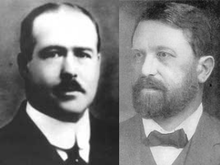Boveri–Sutton chromosome theory

The Boveri–Sutton chromosome theory (also known as the chromosome theory of inheritance or the Sutton–Boveri theory) is a fundamental unifying theory of
It states simply that chromosomes, which are seen in all dividing cells and pass from one generation to the next, are the basis for all genetic inheritance. Over a period of time random mutation creates changes in the DNA sequence of a gene. Genes are located on chromosomes.
Background
"1. The chromosome group of the presynaptic germ-cells is made up of two equivalent chromosome-series, and that strong ground exists for the conclusion that one of these is paternal and the other maternal.
2. The process of synapsis (pseudo-reduction) consists in the union in pairs of the homologous members (i. e., those that correspond in size) of the two series.
3. The first post-synaptic or maturation mitosis is equational and hence results in no chromosomic differentiation.
4. The second post-synaptic division is a reducing division, resulting in the separation of the chromosomes which have conjugated in synapsis, and their relegation to different germ-cells.
5. The chromosomes retain a morphological individuality throughout the various cell-divisions. "
W. S. Sutton, The Chromosomes in Heredity 1903[4]
The chromosome theory of inheritance is credited to papers by
This groundbreaking work led E.B. Wilson in his classic text to name the chromosome theory of inheritance the "Sutton-Boveri Theory".[10] Wilson was close to both men since the young Sutton was his student and the prominent Boveri was his friend (in fact, Wilson dedicated the aforementioned book to Boveri). Although the naming precedence is now often reversed to "Boveri-Sutton", there are some who argue that Boveri did not actually articulate the theory until 1904.[11]
Verification
The proposal that chromosomes carried the factors of Mendelian inheritance was initially controversial, but in 1905 it gained strong support when
References
- ^ a b 1902: Theodor Boveri (1862-1915) and Walter Sutton (1877-1916) propose that chromosomes bear hereditary factors in accordance with Mendelian laws Genetics and Genomics Timeline. Genome News Network an online publication of the J. Craig Venter Institute.
- ^ a b Chromosome theory of inheritance Archived 2010-06-20 at the Wayback Machine Holmgren Lab Northwestern University.
- ^ ISBN 978-0-07-325839-3
- ^ "Sutton, W. S. 1903. The chromosomes in heredity. Biological Bulletin, 4:231-251" (PDF). www.esp.org. 1998. Archived from the original on 2016-03-14. Retrieved 2015-05-05.
- JSTOR 1535510.
- JSTOR 1535741.
- ^ Boveri, T.H. (1904). Ergebnisse über die Konstitution der chromatischen Substanz des Zelkerns. Fisher, Jena.
- PMID 18163986.
- ^ Sutton, W.S. (1902), p. 39.
- ^ Wilson, E.B. (1925). The Cell in Development and Heredity, 3rd edition. Macmillan, New York. p. 923.
- ^ Martins, L.A.-C.P. (1999). Did Sutton and Boveri propose the so-called Sutton-Boveri chromosome hypothesis? Genet. Mol. Biol. [online]. Vol.22, n.2, pp. 261-272 [Retrieved 2011-03-03].
- ^ NM Stevens, (1905) “Studies in Spermatogenesis, with Especial Reference to the ‘Accessory Chromosome,’” Washington, DC, Carnegie Institution of Washington, Publication 36, NM Stevens, (1906) .
- ^ “Studies in Spermatogenesis Part II, A Comparative Study of Heterochromosomes in certain Species of Coleoptera, Hemiptera, and Lepidoptera with Especial Reference to Sex Determination,” Washington, DC, Carnegie Institution of Washington, Publication 36, Part II, (1906)
- S2CID 1919033.
- ^ Crow, E.W. and Crow, J. F. 100 Years Ago: Walter Sutton and the Chromosome Theory of Heredity Genetics, Vol. 160, 1-4, January 2002
External links
- Each Organism's Traits Are Inherited from a Parent through Transmission of DNA SciTable by Nature Education.
